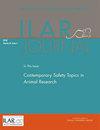Incorporating Laboratory Animal Science into Responsible Biomedical Research.
IF 3.1
3区 农林科学
Q1 VETERINARY SCIENCES
引用次数: 17
Abstract
Biomedical research has made great strides in the past century leading to rapid advances in human life expectancy, all derived from improved understanding, prevention, and treatment of many diseases and conditions. Research involving laboratory animals has played a significant role in this medical progress. However, there continues to be controversy surrounding the use of animals in research, and animal models have been questioned regarding their relevance to human conditions. While research fraud and questionable research practices could potentially contribute to this problem, we argue that a relative ignorance of laboratory animal science has contributed to the "uncontrolled vivarium experiment" that runs parallel to the more controlled scientific experiment. Several variables are discussed, including husbandry, animal environment, social housing, and more, that can contribute to this uncontrolled experiment, and that can simultaneously decrease quality of life for rodent test subjects when ignored. An argument is put forward that laboratory animal veterinarians and scientists can and should play an important role in better controlling such variables. Similarly, the laboratory animal veterinarian and scientist should play an important role in responsible science by addressing complex interdisciplinary challenges.将实验动物科学纳入负责任的生物医学研究。
生物医学研究在过去的一个世纪里取得了长足的进步,导致人类预期寿命的快速提高,这一切都源于对许多疾病和条件的理解、预防和治疗的提高。涉及实验动物的研究在这一医学进步中发挥了重要作用。然而,在研究中使用动物仍然存在争议,动物模型与人类条件的相关性也受到质疑。虽然研究欺诈和可疑的研究实践可能会导致这一问题,但我们认为,对实验室动物科学的相对无知导致了“不受控制的间日动物实验”,该实验与更受控制的科学实验平行。讨论了几个变量,包括畜牧业、动物环境、社会住房等,这些变量可能会导致这一不受控制的实验,并且在被忽视的情况下,会同时降低啮齿动物测试对象的生活质量。有人认为,实验室动物兽医和科学家能够而且应该在更好地控制这些变量方面发挥重要作用。同样,实验室动物兽医和科学家应该通过应对复杂的跨学科挑战,在负责任的科学中发挥重要作用。
本文章由计算机程序翻译,如有差异,请以英文原文为准。
求助全文
约1分钟内获得全文
求助全文
来源期刊

Ilar Journal
农林科学-兽医学
CiteScore
5.10
自引率
20.00%
发文量
8
审稿时长
>18 weeks
期刊介绍:
The ILAR Journal is the peer-reviewed, theme-oriented publication of the Institute for Laboratory Animal Research (ILAR), which provides timely information for all who study, use, care for, and oversee the use of animals in research. The journal publishes original articles that review research on animals either as direct subjects or as surrogates for humans. According to policy, any previously unpublished animal research reported in the ILAR Journal will have been conducted according to the scientific, technical, and humanely appropriate guidelines current at the time the research was conducted in accordance with the Guide for the Care and Use of Laboratory Animals or other guidance provided by taxonomically-oriented professional societies (e.g., American Society of Mammalogy) as referenced in the Guide.
 求助内容:
求助内容: 应助结果提醒方式:
应助结果提醒方式:


